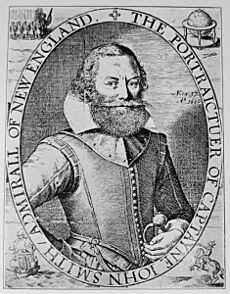List of colonial governors of Virginia facts for kids
A colonial governor was like the main boss or leader of a colony, chosen by the king or a company in charge. This article lists the people who held that important job in the Virginia Colony.
Sometimes, the person officially named "governor" never even came to the New World! They would let someone else, called a "deputy" or "lieutenant governor," do the actual work in Virginia. Because of this, many historical records might just call these deputies "governor" too. Also, traveling from England to Virginia took many months, so the dates when governors served might seem to overlap.
Contents
First English Attempts (1585–1590)
The first English try at settling in Virginia was the "Lost Colony" of Roanoke. Two different governors led these early settlements, but they didn't last. No one knows what happened to the colonists in the end.
- Sir Walter Raleigh, Governor of Virginia (1585–1590, he stayed in England)
- Sir Ralph Lane, Governor of Roanoke (1585–1586)
- John White, Governor of Raleigh (1587–1590)
Virginia Company Governors (1607–1624)
From 1606 to 1624, the Virginia Company of London was in charge of the Virginia Colony. They appointed the governors. Most of these leaders were called "President of the Council," but some were given the title "governor" by the company.
- President of the Council Edward Maria Wingfield (1607)
- President of the Council John Ratcliffe (1608)
- Matthew Scrivener (1608)
- President of the Council John Smith (1608–1609)
- President of the Council George Percy (1609–1610)
- Governor Thomas West, 3rd Baron De La Warr (1609–1618, often away)
- Deputy Governor Sir Thomas Gates (May–June 1610)
- Deputy Governor George Percy (March–May 1611)
- Acting Governor Sir Thomas Dale (May–August 1611)
- Acting Governor Sir Thomas Gates (1611–1613)
- Acting Governor Sir Thomas Dale (1613–1616)
- Lieutenant Governor Sir George Yeardley (1616–1617)
- Lieutenant Governor Sir Samuel Argall (1617–1619)
- Governor Sir George Yeardley (1619–1621)
- Governor Sir Francis Wyatt (1621–1624)
Crown Governors (1624–1652)
In 1624, the King of England took over Virginia from the Virginia Company. It became a "crown colony," meaning it was directly controlled by the English King or Queen. The rulers would then choose the governors.
During a time in England called the Interregnum (1649–1660), England was ruled by a government called the Commonwealth and later by Oliver and Richard Cromwell. These governments also appointed governors for Virginia.
William Berkeley was governor when King Charles I was executed. He stayed in office until a Commonwealth fleet arrived in 1651 and removed him. Later, Berkeley was returned to his job by the Virginia assembly and by King Charles II in 1660.
- Governor Sir Francis Wyatt (1624–1626)
- Governor Sir George Yeardley (1626–1627)
- Acting Governor Francis West (1627–1629)
- Governor Sir John Harvey (1628–1639)
- Governor Sir Francis Wyatt (1639–1642)
- Governor Sir William Berkeley (1642–1652)
- Acting Governor Sir Richard Kemp (1644–1645)
Commonwealth and Protectorate Governors (1652–1660)
These governors were chosen by the English Commonwealth and Protectorate governments, not by a king.
- Governor Richard Bennett (1652–1655)
- Governor Edward Digges (1655–1656)
- Governor Lt. Col. Samuel Mathews (1656–1660, died while in office)
Crown Governors (1660–1775)
After the monarchy was restored in England, kings and queens once again appointed Virginia's governors.
- Governor Sir William Berkeley (1660–1677)
- Lieutenant Governor Francis Moryson (1661–1662)
- Governor Col. Herbert Jeffreys (1677–1678)
- Governor Thomas Culpeper, 2nd Baron Culpeper of Thoresway (1677–1683)
- Lieutenant Governor Sir Henry Chicheley (1678–1680)
- Acting Governor Col. Nicholas Spencer (September 1683–April 1684)
- Governor Francis Howard, 5th Baron Howard of Effingham (1684–1692, away from 1688)
- Gen. Joseph Bridger (1684)
- President of the Council Nathaniel Bacon (1688–1690)
- Lieutenant Governor Francis Nicholson (1690–1692)
- Governor Sir Edmund Andros (1692–1698)
- Governor George Hamilton, 1st Earl of Orkney (1698–1737, he stayed in England)
- Lieutenant Governor Francis Nicholson (1698–1705)
- Lieutenant Governor Col. Edward Nott (1705–1706)
- Acting Governor Edmund Jenings (1706–1710)
- Lieutenant Governor General Robert Hunter (1707, captured at sea and never served)
- Lieutenant Governor Lt. Col. Alexander Spotswood (1710–1722)
- Lieutenant Governor Col. Hugh Drysdale (1722–1726)
- President of the Council Robert "King" Carter (1726–September 1727)
- Lieutenant Governor Sir William Gooch, 1st Baronet (1727–1740)
- Governor Willem Anne van Keppel, 2nd Earl of Albemarle (1737–1754, he stayed in England)
- Acting Governor James Blair (1740–1741)
- Lieutenant Governor Sir William Gooch, 1st Baronet (1741–1749)
- Acting Governor John Robinson Sr. (August 1749)
- Acting Governor Thomas Lee (1749–1750)
- Acting Governor Lewis Burwell (1750–1751)
- Lieutenant Governor Robert Dinwiddie (1751–1756)
- Governor John Campbell, 4th Earl of Loudoun (1756–1759)
- Lieutenant Governor Robert Dinwiddie (1756–January 1758)
- Lieutenant Governor Francis Fauquier (1758–1768)
- Governor Jeffery Amherst (1759–1768, he stayed in England)
- Acting Governor John Blair, Sr. (1768)
- Governor Norborne Berkeley, Baron de Botetourt (1768–1770)
- Acting Governor William Nelson (1770–1771)
- Governor John Murray, 4th Earl of Dunmore (1771–June 1775)
See also
 In Spanish: Anexo:Gobernadores coloniales de Virginia para niños
In Spanish: Anexo:Gobernadores coloniales de Virginia para niños


